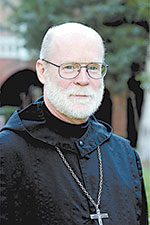 CHARLOTTE — The mystery of transubstantiation – the changing of bread and wine into the Body and Blood of Christ during the consecration at Mass – is a truth many Catholics find difficult to grasp.
CHARLOTTE — The mystery of transubstantiation – the changing of bread and wine into the Body and Blood of Christ during the consecration at Mass – is a truth many Catholics find difficult to grasp.
In fact, a 2019 Pew Research Center poll found that less than one-third of self-described Catholics in the U.S. believe in or know about this core doctrine of our faith.
This was a wake-up call to members of the Charlotte region of the Order of Malta – part of a worldwide lay religious order whose charisms include defense of the Catholic faith as well as care for the sick and the poor.
“Obviously, we have a lot of defending to do,” said Knight of Malta Rick Menze.
The order is hosting periodic educational talks to deepen people’s understanding of the Catholic faith and the ability to explain it to others. First among their efforts has been two talks by Benedictine Abbot Placid Solari of Belmont Abbey, chaplain for the order’s Charlotte region.
Abbot Placid’s talks via video conference dove into this teaching, focusing on Church documents including St. Paul VI’s 1965 encyclical “Mysterium Fidei” (“The Mystery of Faith”), Pope Benedict XVI’s 2007 apostolic exhortation “Sacramentum Caritatis” (“The Sacrament of Charity”); and information from the pivotal Council of Trent in the 16th century.
The Eucharist is the real Presence of Christ, Abbot Placid explained, and that has consistently remained Church teaching since Jesus first spoke the words of consecration at the last Supper and directed the Apostles to “Do this in memory of Me.”
How the elements of bread and wine change into His Body and Blood is a mystery that the Church best describes as “transubstantiation”: we still see the physical appearance of bread and wine, but the underlying substance is transformed into a new reality seen only through the eyes of faith.
The bread and wine are not mere symbols, Abbot Placid noted. “The bread and wine cease to exist, and the Body and Blood become present.”
The word “transubstantiation” derives from ancient philosophy, and refers to the concept that something has a fundamental essence (“substance”) separate from its physical properties (called “accidents” or “species”). For example, a chair remains a chair (its substance) no matter whether it’s made of wood, metal or any other material (its accidents).
‘The Council of Trent summarizes the Catholic faith by declaring: ‘Because Christ our Redeemer said that it was truly His Body that he was offering under the species of bread, it has always been the conviction of the Church of God, and this holy Council now declares again, that by the consecration of the bread and wine there takes place a change of the whole substance of the bread into the substance of the Body of Christ our Lord and of the whole substance of the wine into the substance of His Blood. This change the holy Catholic Church has fittingly and properly called transubstantiation.’”
— Catechism of the Catholic Church 1376
Through the Eucharistic prayer spoken by the priest – acting in the person of Christ, the bread is changed by the efficacy of the word of Christ and by the action of the Holy Spirit.
The Apostles accepted this truth and the early Church Fathers reflected on its meaning, and through the centuries the Church has sought to understand it more deeply – yet ultimately the transformation of bread and wine into Christ’s Body and Blood “goes beyond the laws of nature,” Abbot Placid said.
Learning more about this central tenet of our faith is important for every Catholic, he urged. “We accept by faith, but we seek to understand.”
“I always accepted by faith that in the Eucharist, it was the changing of bread and wine into the Body and Blood of Christ. But the presentation by Abbot Placid using the term ‘transubstantiation’ helped explain the process and helped me focus on the importance of the sacredness of this moment during each Mass,” said Kaye McGarry, Dame of Malta. “It helped deepen my belief in the meaning of the Eucharist.”
— Patricia L. Guilfoyle, Editor
More online
Links to the Church documents referenced by Abbot Placid Solari, including St. Paul VI’s 1965 encyclical “Mysterium Fidei” (“The Mystery of Faith”), Pope Benedict XVI’s 2007 apostolic exhortation “Sacramentum caritatis” (“The Sacrament of Charity”).
Documents from the Council of Trent
- Brief summary of the Council of Trent: https://www.britannica.com/event/Council-of-Trent and https://www.britannica.com/topic/Roman-Catholicism/The-Roman-Catholic-Reformation#ref479481
- Documents of the Council of Trent: https://www.papalencyclicals.net/councils/trent.htm
- Bishop Barron on the Council of Trent: https://www.youtube.com/watch?v=VRZK92T8k28&vl=en
At www.therealpresence.org: Read more about the Eucharist as “the source and summit of our faith,” stories of Eucharistic miracles, tips for participating in Eucharistic Adoration and much more


